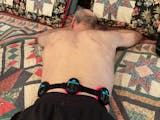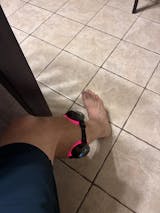Exploring the Science Behind Cutting-Edge Red Light Therapy Devices
How Red Light Therapy Became the Latest Trend
Light therapy has been around for decades in select communities, but just recently started making its way mainstream with the advent
of medical-grade, at-home light therapy devices. Red light has been widely studied in clinical studies around the world over the last 20 years, including research at NASA in the 1980s. Throughout all the peer-reviewed clinical research, red light is observed to be safe and effective at promoting a wide range of health benefits with very little side effects or adverse reactions.
Sunlight includes a component of red light; it is this light wavelength that contributes to the enhanced sense of well-being we experience after a few hours outdoors. LED light therapy devices, such as those offered by PRUNGO, harness the regenerative healing red light wavelengths, without the more problematic UVA and UVB light rays that can cause skin cancer and premature aging. LED light therapy, therefore, is the therapeutic science of utilizing red and infrared light wavelengths to assist with the treatment of health conditions, and promote general well-being.
What is Polarized Laser Therapy?
Polarized Laser Therapy(PLT) is a specialized form of photobiomodulation therapy (PBMT) that uses lasers with specific polarization characteristics to enhance therapeutic outcomes. Unlike traditional laser therapies that use non-polarized light, PLT adjusts the laser beam to a precise polarized state, allowing for more focused and efficient tissue penetration.
PRUNGO® is the only brand that combines high-safety 3R-grade lasers with polarized filters and highly concentrated LED arrays for red light therapy. Through clinical trials, PRUNGO has successfully developed polarized filters, commonly used in large medical devices, to be compatible with at-home red light devices. The combination of lasers and polarized filters maximizes the penetration of near-infrared light while significantly reducing light scattering. Polarized laser therapy is especially effective for treating deep tissue damage, musculoskeletal pain, and inflammation. The overall clinical benefits include unmatched accelerated healing, as well as relief from pain, inflammation, swelling, and related symptoms. It offers a non-invasive, highly targeted treatment approach.
Light Spectrum in Red Light Therapy
The effectiveness of wavelengths of light with respect to photobiomodulation therapy can be characterized by the action spectra of the target photoacceptors (e.g. cytochrome c oxidase), that determine the positive biological responses such as increased metabolism, cellular regeneration and immunomodulation. The most clinically effective wavelength ranges are in the red (630-680 nm) and near infrared spectra (810-850 nm). Wavelength is one critical parameter of light among other factors such as dosage or energy density (J/cm2), treatment time and light delivery in pulses (cycles per second or Hz) in determining the efficiency of absorption, depth of penetration and ultimately the clinical outcomes. The effects of photobiomodulation are cumulative and can be clinically evident immediately after treatment or over a period of days.
Red Light
Since the introduction of the He-Ne laser (632.8 nm) in the 1960s, the positive effects of red light wavelengths (λ = 630-680 nm) have been established both in vitro and human clinical trials. These wavelengths are highly absorbed by cytochrome c oxidase, one of the terminal enzymes in the electron transport chain responsible for the creation of ATP. Cells and tissues under metabolic stress due to injury or disease will repair and recover much faster when exposed to these red wavelengths as a direct result of increased ATP production and increased cellular metabolism.
Red wavelengths are also absorbed to some degree by other photoacceptors in the skin including hemoglobin and melanin which limits the effective depth of penetration to the subcutaneous regions of the body (approximately 5-10 mm).
Red wavelengths principally in the 630-680 nm range are very beneficial for treating conditions that are relatively superficial such as subcutaneous bursitis, skin conditions like acne, psoriasis, hair loss and eczema as well as wounds and chronic ulcers. The large network of capillaries located in the subcutaneous region will also absorb red wavelengths resulting in a powerful immunomodulating effect by the activated white blood cells, stem cells and platelets. This is called a systemic or remote effect and it produces an anti-inflammatory and healing effect that is circulated by the activated white blood cells to injured and diseased tissues deep to the treated area.
Near-infrared light
Near Infrared wavelengths are also known to be absorbed by cytochrome c oxidase and other photoreceptors that result in positive effects on cellular physiology. Tiina Karu was the one of the key researchers to establish the photoabsorption spectra of these photoacceptors as well as the ranges of wavelengths that result in optimal photobiomodulation. She observed near infrared wavelengths in the ranges of 810-850 nm were most active, making them more effective for deeper lying injuries and conditions associated with musculoskeletal conditions.
These near infrared wavelengths are much less absorbed by hemoglobin and other photoacceptors that prevent light from penetrating more deeply. As a result, light in the range of 810-850 nm are considered to be the most transparent of the wavelengths used in photobiomodulation therapy allowing for much deeper effective penetration of several cm. The actual clinical effective depth of penetration varies as a result of factors like skin colour, tissue density, power, treatment time and using contact technique.
Tissues like bone, tendon, muscle, adipose and ligament vary with respect how much light can effectively penetrate and accumulate to a dosage high enough to result in a photobiomodulation effect. When trying to elicit a direct photobiomodulation effect on these types of tissues, near infrared wavelengths (810-850 nm) are the most effective and are the “go to” wavelength range to heal these deeper tissues. Using greater power is one way to increase the dosage more quickly in these deeper tissues.
Clinical Effects of Red Light Therapy
What Red Light Therapy Can Do

Pain Management
Red light helps alleviate pain by promoting circulation and reducing inflammation in affected areas.

Joint & Inflammation Treatment
It reduces joint pain and inflammation by enhancing cellular repair and reducing swelling.

Improve Muscle Recovery
Red light speeds up muscle recovery by increasing ATP production and reducing muscle soreness.

Faster Wound Healing & Post-Surgery Recovery
It accelerates healing by stimulating cell regeneration and improving tissue repair.

Nervous System Support
It supports the nervous system by improving blood flow and reducing oxidative stress, aiding in nerve function.

Immune System Boost
Red light enhances immune response by stimulating the production of white blood cells and improving circulation.

Beauty & Skin Care
Red light promotes collagen production, helping to reduce wrinkles and improve skin tone and texture.

Mental Health & Mood Support
It helps improve mood and mental clarity by regulating stress hormones and promoting relaxation.





























